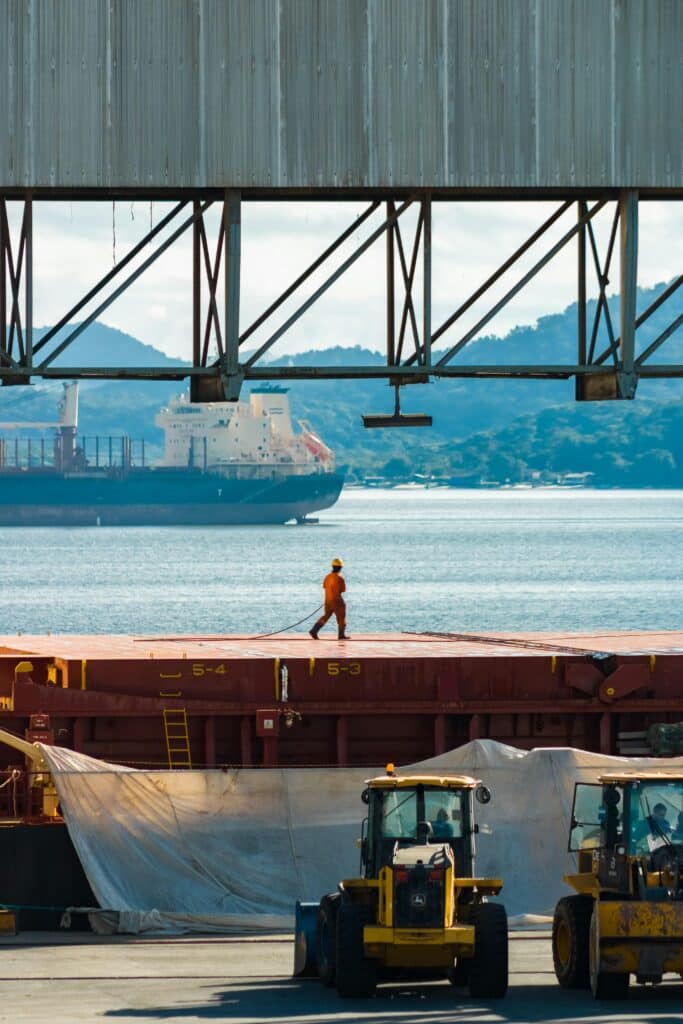Overview of the Gulf Dockworkers Strike
The Gulf and East Coast port strike was a significant event that began on October 1, 2024, when about 45,000 dockworkers at 36 ports from Maine down to Texas decided to walk off the job. This action was a result of stalled negotiations between the International Longshoremen’s Association (ILA) and the U.S. Maritime Alliance (USMX), the group representing port operators. The workers’ demands focused on wage increases and protections against job losses from increased automation at the ports. The union argued that without safeguards, port automation could eventually cut many traditional longshore jobs, and they were pushing for limits on this technology as part of their new contract
The strike lasted three days, creating a ripple effect that delayed shipments and impacted industries relying on a steady flow of goods—especially perishable items like produce and time-sensitive retail products. After three days of halted port operations, the two sides reached a temporary agreement on October 4, which allowed workers to return to work while negotiations continued. This agreement, set to last until January 15, 2025, effectively bought time to discuss a more permanent solution.
Although relatively short, the strike caused noticeable disruptions across the supply chain. With goods piled up at these critical ports, it created a backlog that’s likely to take weeks to fully clear. As operations resumed, it became clear that even a short strike like this can have prolonged consequences, especially as businesses head into the peak holiday season and try to catch up on delayed shipments. The strike serves as a reminder of how dependent various industries are on smooth port operations and how vulnerable supply chains can be to labor disputes at major shipping hubs.
What Does This Mean for the Economy and Supply Chains?
Although the Gulf port strike was short-lived, its effects on the economy and supply chains are expected to extend well beyond the immediate disruption. The strike caused delays in unloading and shipping goods, and now businesses are working to clear backlogs and get delayed shipments back on schedule. Even as port operations have resumed, industry experts predict that the consequences will likely be felt through the end of the year, especially as demand peaks during the holiday season
For the economy, port disruptions like this create a ripple effect. Delays in getting goods to market lead to higher transportation costs, which companies may pass on to consumers. Retailers, for instance, are now facing increased pressure to get products on shelves for the holidays, which could lead to higher shipping rates and expedited fees as they try to make up for lost time. In addition, the strike added to the ongoing challenges businesses face with fluctuating shipping costs and supply chain unpredictability
From a supply chain perspective, the strike highlights the vulnerability of ports as critical hubs. Supply chains already stressed from previous disruptions may struggle to handle additional delays, especially for industries dependent on imported goods. For example, companies that rely on “just-in-time” inventory methods—where goods arrive as close to production or sale as possible—are particularly sensitive to port slowdowns. The delays and costs associated with rerouting shipments to other ports or using alternative shipping methods could pressure these businesses even after port operations stabilize.
Experts are also keeping an eye on how this disruption might contribute to inflationary pressures. “This is clearly transitory. They will have some resolution,” said Christopher Ball, economics professor at Quinnipiac University. “That being said, in the short run, if it lasts more than a few days, if it lasts more than a week … that will certainly push up the prices of a lot of those goods and services now. It could cause price spikes in the short run during the strike, and I can easily see that pushing up prices of certain goods a lot.”
With inflation already a concern, any prolonged strain on logistics could push prices higher, particularly for imported goods. When retailers face rising costs from disrupted supply chains and rerouted shipping, they often pass those costs to customers. According to recent inflation reports, prices in key categories, such as food and consumer goods, have seen steady increases, and logistics costs are a part of this picture
Looking forward, companies are likely to consider adjustments in their logistics strategies to better prepare for these kinds of disruptions. Diversifying shipping routes, building more flexibility into inventory management, and collaborating with logistics partners for contingency plans are measures that can help minimize the impact of similar future events on costs and product availability.
What Does This Mean for Freight Shippers?
With the Gulf port strike temporarily resolved but only under a tentative agreement through January 2025, freight shippers face an uncertain landscape. While operations are back on track for now, shippers are left questioning what might happen if a long-term contract is not reached in January. This strike has underscored the vulnerability of East and Gulf Coast ports, particularly for freight shippers who need reliability and predictability in their logistics.
Immediate Lessons from the Strike and Preparations for January 2025
For shippers, this short-lived strike has been a wake-up call. Historically, labor disruptions at major ports have triggered costly ripple effects across the supply chain. For instance, the 2014-2015 West Coast port slowdown created massive congestion that led to months of costly delays and inflated shipping rates, impacting sectors from agriculture to electronics. This recent Gulf strike, though shorter, had similar effects by stalling shipments for days, leading to backlogs and scheduling inconsistencies that could extend into the holiday season.
Given that labor negotiations remain ongoing, freight shippers may need to prepare for a potential repeat disruption in January. In the interim, companies should assess how flexible their logistics strategies are and consider alternative shipping routes or partnerships. Exploring West Coast ports, investing in cross-docking options, and having contingency plans for expedited LTL services are critical moves to reduce exposure to Gulf and East Coast ports if a prolonged strike occurs after the January deadline.
Long-Term Adjustments and Resilience in the Face of Potential Future Strikes
Looking beyond January, shippers can implement strategic adjustments to safeguard against long-term disruption risks. Since port strikes and labor disputes have historically caused major logistical setbacks, companies may benefit from diversifying their entry points and working with freight providers who offer a broad geographical network. By increasing reliance on West Coast ports or even exploring Canada’s port options (such as Vancouver or Prince Rupert), companies can reduce dependency on the Gulf and East Coast hubs.
Additionally, freight shippers could benefit from adopting more resilient inventory strategies. The “just-in-time” inventory model, though cost-efficient, leaves little room for delays, which can cause serious backlogs if port activity is disrupted. Some companies are now revisiting inventory models that build in extra supply buffers, allowing for a smoother recovery if delays occur at key ports.
Economic and Operational Costs of Future Disruptions
Freight shippers also need to be mindful of the potential economic implications if negotiations in January do not lead to a stable contract. The costs associated with shifting logistics midstream—like rerouting cargo, increasing truckload services, or using air freight for urgent deliveries—can be significant. Prolonged disruptions often drive up operational costs, as demand for alternatives like trucking and air freight surges. As witnessed during the pandemic, elevated demand can lead to price spikes that have a cascading effect on final goods prices.
Freight shippers should monitor the progress of these negotiations closely. Many are already incorporating these higher potential logistics costs into their annual budgets, accounting for the possibility of a continued trend in labor disputes influencing shipping rates. Additionally, freight brokerage services, like those provided by Freight Hitch, can offer valuable flexibility in securing capacity and rates for both routine and urgent shipments, making them a strategic ally during uncertain times.
Balancing Cost, Flexibility, and Long-Term Planning
In light of these uncertainties, freight shippers need to weigh the cost of flexibility versus the risk of disruption. This involves looking at partnerships that offer options across multiple regions, exploring less-used ports, and potentially securing contracts that lock in rates for longer periods. Although such measures can be costlier upfront, they offer a buffer against the unpredictability of strikes and other disruptions.
As January approaches, shippers are likely to adopt a more cautious approach, balancing immediate shipping needs with contingency plans for potential disruptions. Building relationships with brokers who have access to a wide carrier network and utilizing both domestic and international routes can mitigate some of the pressure. This more comprehensive approach to logistics planning enables shippers to better manage the risk posed by future labor disruptions, whether they are localized to one region or extend across multiple key ports.
Labor Market and Wages: Impacts on Hiring and Compensation in the Freight Industry
The recent port strike doesn’t just influence shipping schedules and costs; it also has implications for the labor market, particularly in terms of wages and hiring dynamics within the freight and logistics industry. For companies like Freight Hitch, which both hire truckers and serve clients in need of transportation solutions, this labor disruption offers insights into how worker demands and industry responses might shape the future of freight.
Implications for Freight Companies Hiring Workers
Labor disputes such as the Gulf port strike often lead to increased scrutiny on wages, benefits, and working conditions across the freight industry. As unions demand higher wages and better job protections, other sectors of logistics, including trucking, may see a rise in wage expectations. For Freight Hitch and similar companies, this can mean having to adjust compensation packages to stay competitive. When port workers secure better wages or enhanced protections, it sets a precedent that ripples through other logistics roles, such as truck drivers and warehouse staff, potentially raising baseline wages industry-wide.
To manage these potential cost increases, freight companies may focus on hiring more flexible contract or part-time workers who can help balance the workload during peak periods without the commitment of full-time benefits. Additionally, companies might invest in training or upskilling programs to improve employee retention, as experienced workers become even more valuable in a labor-tight market.
Impacts on Companies Using Freight Services
For businesses relying on freight shipping, increased labor costs often translate into higher rates for transport and logistics services. Clients of freight companies may face rising costs in the medium to long term if the industry adapts to higher wage demands. For instance, a client shipping goods through Freight Hitch could see their expenses increase as trucking rates adjust to cover higher compensation for drivers and port-related costs.
To adapt, companies that rely on freight services can consider renegotiating long-term contracts with shippers, incorporating flexible pricing structures that anticipate cost fluctuations related to labor disputes. In addition, clients may explore more collaborative relationships with freight providers to develop cost-sharing strategies during periods of peak demand or workforce shortages, helping both parties mitigate the impact of wage-related adjustments in logistics.
Looking Forward: Labor Stability and Strategic Hiring
The ripple effects of the Gulf port strike highlight the ongoing conversation about worker treatment, automation, and wage standards in logistics. Companies that act proactively to address potential wage pressures and optimize hiring practices can better position themselves against future disruptions. By implementing strategies that support employee satisfaction—such as clear career progression paths and competitive pay structures—freight companies can build resilience in their workforce.
As the freight industry becomes more competitive and freight shippers prioritize reliable partners, companies that offer fair wages, solid working conditions, and strong operational support will stand out.
Conclusion: Navigating Uncertainty with a Reliable Partner
The recent Gulf port strike underscores the fragility of our interconnected supply chains, particularly for businesses that rely on a steady flow of goods to keep their operations running smoothly. While the immediate disruption is behind us, the potential for future labor disputes and rising logistics costs highlights the importance of resilience and adaptability in freight planning. Freight shippers face a critical choice: work with partners who can provide transparent, reliable solutions or risk being unprepared when the next disruption occurs.
Freight Hitch stands out as a strategic partner for shippers navigating these turbulent times. With a focus on transparent communication, flexible shipping options, and expedited LTL services, Freight Hitch helps clients adapt quickly and keep their shipments on track—even when the unexpected occurs. For businesses prioritizing stability and efficiency in their logistics, Freight Hitch offers the dependable service and insights needed to stay ahead.
For a freight partner you can trust to deliver your goods reliably and adapt to industry challenges, visit freighthitch.com.

References
- C.H. Robinson: Update on the U.S. East Coast and Gulf Coast Dock Strike, October 2024
- Freight Waves: Impact of the Gulf Dock Strike on U.S. Supply Chains
- Supply Chain Dive: Overview and Analysis of the Recent Dockworker Strike
- Institute for Supply Management: East and Gulf Coast Dockworkers Strike: Disrupting Supply Chains and the Economy
- Fox 4 News: Latest Deal Reached in the 2024 Port Strike
- AARP: How the East and Gulf Coast Port Strike Affects You
- CNBC: Port Strike Could Reignite Inflation with Economic Impact Dependent on Duration




